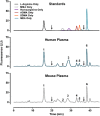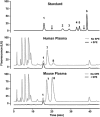Resolution and quantification of arginine, monomethylarginine, asymmetric dimethylarginine, and symmetric dimethylarginine in plasma using HPLC with internal calibration
- PMID: 26130049
- PMCID: PMC4755038
- DOI: 10.1002/bmc.3548
Resolution and quantification of arginine, monomethylarginine, asymmetric dimethylarginine, and symmetric dimethylarginine in plasma using HPLC with internal calibration
Abstract
N(G) ,N(G) -dimethyl-l-arginine (asymmetric dimethylarginine, ADMA),N(G) -monomethyl-l-arginine (l-NMMA) and N(G) ,N(G') -dimethyl-l-arginine (symmetric dimethylarginine, SDMA) are released during hydrolysis of proteins containing methylated arginine residues. ADMA and l-NMMA inhibit nitric oxide synthase by competing with l-arginine substrate. All three methylarginine derivatives also inhibit arginine transport. To enable investigation of methylarginines in diseases involving impaired nitric oxide synthesis, we developed a high-performance liquid chromatography (HPLC) assay to simultaneously quantify arginine, ADMA, l-NMMA and SDMA. Our assay requires 12 μL of plasma and is ideal for applications where sample availability is limited. We extracted arginine and methylarginines with mixed-mode cation-exchange columns, using synthetic monoethyl-l-arginine as an internal standard. Metabolites were derivatized with ortho-phthaldialdeyhde and 3-mercaptopropionic acid, separated by reverse-phase HPLC and quantified with fluorescence detection. Standard curve linearity was ≥0.9995 for all metabolites. Inter-day coefficient of variation (CV) values were ≤5% for arginine, ADMA and SDMA in human plasma and for arginine and ADMA in mouse plasma. The CV value for l-NMMA was higher in human (10.4%) and mouse (15.8%) plasma because concentrations were substantially lower than ADMA and SDMA. This assay provides unique advantages of small sample volume requirements, excellent separation of target metabolites from contaminants and validation for both human and mouse plasma samples.
Keywords: ADMA; Arginine; L-NMMA; Nitric Oxide Synthase; SDMA; Vascular Homeostasis.
© 2015 The Authors Biomedical Chromatography published by John Wiley & Sons, Ltd.
Figures



References
-
- Achan V, Broadhead M, Malaki M, Whitley G, Leiper J, MacAllister R and Vallance P. Asymmetric dimethylarginine causes hypertension and cardiac dysfunction in humans and is actively metabolized by dimethylarginine dimethylaminohydrolase. Arteriosclerosis, Thrombosis, and Vascular Biology 2003; 23: 1455–1459. DOI:10.1161/01.ATV.0000081742.92006.59. - DOI - PubMed
-
- Bishop MJ, Crow B, Norton D, Paliakov E, George J and Bralley JA. Direct analysis of un‐derivatized asymmetric dimethylarginine (ADMA) and l‐arginine from plasma using mixed‐mode ion‐exchange liquid chromatography–tandem mass spectrometry. Journal of Chromatography B 2007; 859: 164–169. DOI:10.1016/j.jchromb.2007.09.024. - DOI - PubMed
-
- Blackwell S, O'Reilly DS and Talwar DK. HPLC analysis of asymmetric dimethylarginine (ADMA) and related arginine metabolites in human plasma using a novel non‐endogenous internal standard. Clinica Chimica Acta 2009; 401: 14–9. DOI:10.1016/j.cca.2008.10.032. - DOI - PubMed
-
- Bode‐Böger SM, Scalera F, Kielstein JT, Martens‐Lobenhoffer J, Breithardt G, Fobker M and Reinecke H. Symmetrical dimethylarginine: a new combined parameter for renal function and extent of coronary artery disease. Journal of the American Society for Nephrology 2006; 17: 1128–1134. DOI:10.1681/ASN.2005101119. - DOI - PubMed
Publication types
MeSH terms
Substances
Grants and funding
LinkOut - more resources
Full Text Sources
Other Literature Sources

